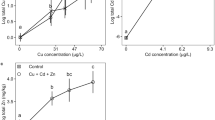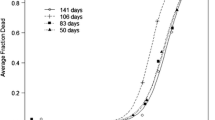Abstract
Fish in the embryo-larval stage of development have been shown to be sensitive to boron (B) at both ends of the dose-response curve (1,2). The present study evaluated the health effects of low and high B concentrations on rainbow trout (Oncorhynchus mykiss), a cold water species, and zebrafish (Danio rerio), a warm water species. Rainbow trout embryos were incubated from day 1 until 2 wk posthatch in Type 1 ASTM ultrapure-grade water (12.5°C) supplemented with only B (0-500 μM) as boric acid, or together with CaCO3 (0–2 mM) to increase water hardness. Embryonic growth was stimulated by B in a dose-dependent manner at all Ca concentrations (p < 0.001). Chronic exposures below 9 μmol B/L impaired embryonic growth and above 10 mmol B/L caused death (p < 0.001). Thus, the safe range of exposure for the rainbow trout was between the adverse effect concentrations of 9 μmol B/L and 10 mmol B/L. Zebrafish were maintained for 6 mo in ultrapure water containing <0.2 μmol B/L to determine the effect of low-level exposure. High-level exposure was assessed by exposing zygotes, derived from parents maintained at 46 μmol B/L, to graded concentrations of boric acid up to a concentration of 75 mmol B/L from fertilization until they were free feeding (96 h). Fertilization occurred, but zygotes failed to survive when water contained <0.2 umol B/L (p < 0.001). Death occurred at and above 9.2 mmol B/L. Thus, the safe range of B exposure for zebrafish was between the adverse effect concentrations of 0.2 μmol B/L and 9.2 mmol B/L. The dose-response for both species was thus U-shaped.
Similar content being viewed by others
References
C. Eckhert, Embryonic trout growth and boron exposure,FASEB J. 11, A406 (1997).
J. A. Black, J. B. Barnum, and W. J. Birge, An integrated assessment of the biological effects of boron to the rainbow trout,Chemosphere 26, 1382–1413 (1993).
L. Butterwick, N. DeOude, and K. Raymond, Safety assessment of boron in aquatic and terrestrial environments,Ecotoxicology Environ. Safety 17, 339–371 (1989).
D. M. Perry and I. H. Suffet, Boron Environmental Chemistry, Distribution, Bioaccu-mulation, and Toxicity in Aquatic Systems and Recommendations for Establishment of a Boron Water Quality Criterion for Natural Waters in the San Joaquin Valley, California. Report to the Central Valley Regional Water Quality Control Board of the California Environmental Protection Agency, Sacramento, CA (1994).
US Geological Survey, V. E. McKelvey, Quality of Surface Waters of the United States, Part II, pp. 1–349. Pacific Slope Basins in California. Geological Survey Water-Supply Paper 2149, pp 1–349 (1969).
US Geological Survey, vol. 3, Southern Central Valley Basins and the Great Basin from Walker River to Truckee River, p. 444 (1978).
US Geological Survey, vol. 2, Pacific Slope Basins from Arroyo Grands to Oregon State Line Except Central Valley, p. 524 (1979).
US Geological Survey, vol. 4, Northern Central Valley Basins and the Great Basin from Honey Lake Basin to Oregon State Line, p. 523 (1980).
F. T. Bingham, The Boron Concentrations of Wild Trout Streams in California, Report to the Procter & Gamble Company, Ivorydale Technical Center, Cincinnati, OH, p. 45,217 (1982).
C. Eckhert, Boron stimulates embryonic trout growth,J. Nutr.,128, 2488–2493 (1998).
S. J. Hamilton and K. J. Buhl, Acute toxicity of boron, molybdenum, and selenium to fry chinook salmon and coho salmon,Arch. Environ. Contam. Toxicol. 19, 366–373 (1990).
Standard Methods, Standard methods for the examination of water and wastewater, American Public Health Association, Washington, DC (1985).
W. J. Dixon and F.J. MasseyJr.,Introduction to Statistical Analysis, 4th ed., McGrawHill, New York(1983).
J. A. J. Thompson, J. C. Davis, and R. E. Drew, Toxicity, uptake and survey studies of boron in the marine environment,Water Res. 10, 869–875 (1976).
W. J. Birge and J. A. Black, Sensitivity of Verterate Embryos to Boron Compounds, Report No. EPA-560/1-76-008, Environmental Protection Agency, Office of Toxic Substances, Washington, DC (1977).
D. L. Eaton and C. D. Klaassen in Casarett and Doull’sToxicology, The Basic Science of Poisons, C. D. Klaassen, ed., McGraw-Hill, New York, pp. 13–33 (1996).
Author information
Authors and Affiliations
Rights and permissions
About this article
Cite this article
Rowe, R.I., Bouzan, C., Nabili, S. et al. The response of trout and zebrafish embryos to low and high boron concentrations is U-shaped. Biol Trace Elem Res 66, 261–270 (1998). https://doi.org/10.1007/BF02783142
Published:
Issue Date:
DOI: https://doi.org/10.1007/BF02783142




